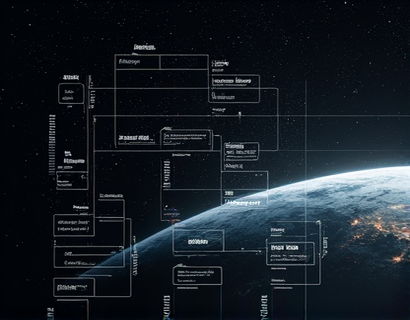Economic Dynamics and Market Opportunities in Modern Ecosystems: Insights for Navigating Success
The landscape of modern economies has evolved significantly, transforming traditional notions of market dynamics and opportunities. This comprehensive guide explores the intricate economic dynamics of contemporary ecosystems, offering strategic insights and detailed analysis to help professionals across various fields identify and capitalize on emerging market opportunities. For economists, business leaders, investors, and industry experts, understanding these dynamics is crucial to staying competitive and informed in today's rapidly changing economic environment.
Modern ecosystems, often referred to as economic ecosystems or innovation ecosystems, encompass a complex network of interconnected entities including businesses, institutions, individuals, and technologies. These ecosystems are characterized by their ability to foster innovation, drive growth, and adapt to changing conditions. The interplay between various components within these ecosystems creates unique economic dynamics that can be leveraged for strategic advantage.
Understanding Economic Ecosystems
An economic ecosystem can be defined as a system where different economic actors collaborate and compete within a shared environment. This environment includes physical infrastructure, social networks, information flows, and regulatory frameworks. The key players in these ecosystems include firms of various sizes, startups, research institutions, government bodies, and consumers. Each player contributes to the ecosystem's overall functionality and resilience.
The concept of economic ecosystems draws parallels with biological ecosystems, where diverse species interact in a balanced and dynamic environment. Similarly, in economic ecosystems, the interaction between different entities leads to innovation, efficiency, and sustainable growth. Understanding the structure and dynamics of these ecosystems is essential for identifying opportunities and navigating challenges.
Key Drivers of Economic Dynamics in Modern Ecosystems
Several factors drive the economic dynamics within modern ecosystems. These drivers create a complex interplay that influences market opportunities and competitive landscapes.
Technological Innovation
Technological advancements are a primary driver of economic dynamics. Innovations in areas such as artificial intelligence, blockchain, and renewable energy are reshaping industries and creating new market spaces. For instance, the rise of AI has led to the development of smart cities, autonomous vehicles, and personalized healthcare solutions. These innovations not only disrupt existing markets but also open up new avenues for growth and investment.
Businesses that embrace and integrate cutting-edge technologies can gain a competitive edge, improve operational efficiency, and create value for customers. However, the rapid pace of technological change also poses challenges, requiring continuous learning and adaptation.
Globalization and Connectivity
Globalization has significantly impacted economic ecosystems by increasing connectivity and interdependence. The ease of cross-border trade, investment, and collaboration has led to the emergence of global value chains and supply networks. This interconnectedness allows businesses to access new markets, resources, and talent pools, fostering innovation and growth.
However, globalization also introduces challenges such as increased competition, regulatory complexities, and geopolitical risks. Companies must navigate these challenges by building robust global strategies and fostering strong international partnerships.
Regulatory Environment
The regulatory framework plays a crucial role in shaping economic dynamics. Government policies, regulations, and incentives can either facilitate or hinder innovation and growth. For example, supportive policies for renewable energy have accelerated the adoption of sustainable technologies, creating new market opportunities.
Conversely, stringent regulations can pose barriers to entry and innovation. Businesses and policymakers must work together to strike a balance between regulation and innovation, ensuring that the ecosystem remains dynamic and inclusive.
Consumer Behavior and Demand
Consumer behavior and demand are pivotal in driving economic dynamics. Shifts in consumer preferences, driven by factors such as sustainability, health consciousness, and digital adoption, influence market trends and business strategies. Companies that align their offerings with evolving consumer needs can capture significant market share.
Data analytics and market research play a vital role in understanding consumer behavior. By leveraging big data and advanced analytics, businesses can gain insights into consumer preferences, predict market trends, and tailor their products and services accordingly.
Identifying Market Opportunities
Within the complex dynamics of economic ecosystems, identifying market opportunities requires a strategic and forward-looking approach. Here are some key strategies for professionals to capitalize on emerging opportunities:
Leverage Technological Trends
Staying abreast of technological trends and integrating relevant innovations can open new market opportunities. For instance, the growth of the Internet of Things (IoT) presents opportunities in smart manufacturing, connected healthcare, and intelligent transportation systems. Businesses that invest in IoT technologies can enhance efficiency, reduce costs, and create value-added services.
Additionally, emerging technologies like 5G, quantum computing, and augmented reality are poised to transform various industries. Early adopters and innovators in these areas can capture significant market share and set industry standards.
Focus on Sustainability and ESG
Sustainability and environmental, social, and governance (ESG) considerations are becoming increasingly important for businesses and investors. Companies that prioritize sustainability can tap into the growing demand for eco-friendly products and services. This not only enhances brand reputation but also opens up new market segments.
Investing in renewable energy, sustainable materials, and circular economy models can provide a competitive advantage. Moreover, aligning with ESG principles can attract socially conscious investors and consumers, further boosting market opportunities.
Explore Emerging Markets
Emerging markets offer significant growth potential due to their rapidly expanding economies, increasing consumer base, and burgeoning middle class. These markets present opportunities in areas such as consumer goods, infrastructure, and technology services.
However, entering emerging markets requires a deep understanding of local dynamics, cultural nuances, and regulatory environments. Businesses should adopt a localized approach, building strong partnerships and tailoring their strategies to meet local needs and preferences.
Foster Innovation and Collaboration
Collaboration and innovation are key to unlocking new market opportunities. Engaging in partnerships with startups, research institutions, and other industry players can drive innovation and accelerate product development. Open innovation models, where companies collaborate externally to solve complex problems, can lead to breakthrough solutions and new business models.
Additionally, fostering a culture of innovation within organizations is essential. Encouraging experimentation, risk-taking, and continuous learning can create a dynamic and adaptive workforce capable of navigating and thriving in a rapidly changing market landscape.
Navigating Challenges in Economic Ecosystems
While the opportunities in modern economic ecosystems are vast, businesses and professionals must also be prepared to address the associated challenges:
Managing Complexity and Uncertainty
The complexity and dynamic nature of economic ecosystems can create uncertainty and make decision-making challenging. To navigate this complexity, businesses should adopt agile and flexible strategies, leveraging data-driven insights and scenario planning to anticipate and respond to changes.
Building a robust organizational structure with cross-functional teams can also enhance the ability to manage complexity and make informed decisions.
Addressing Regulatory and Ethical Concerns
Regulatory and ethical considerations are increasingly important in shaping business operations and market opportunities. Compliance with evolving regulations and adherence to ethical standards are non-negotiable. Companies must proactively engage with regulators, industry bodies, and stakeholders to ensure compliance and build trust.
Moreover, addressing ethical concerns such as data privacy, labor practices, and environmental impact can enhance brand reputation and consumer trust, providing a competitive edge in the market.
Mitigating Risks and Building Resilience
Economic ecosystems are subject to various risks, including market volatility, geopolitical tensions, and technological disruptions. To mitigate these risks, businesses should develop comprehensive risk management strategies, diversify their operations, and build resilient supply chains.
Investing in cybersecurity, business continuity planning, and crisis management can help organizations withstand and recover from disruptions, ensuring long-term sustainability and growth.
Conclusion
Understanding the economic dynamics of modern ecosystems is essential for professionals seeking to navigate and capitalize on emerging market opportunities. By leveraging technological innovations, embracing sustainability, exploring new markets, and fostering collaboration, businesses can unlock significant growth potential. However, success in these ecosystems also requires addressing complexity, regulatory challenges, and risks through strategic planning and resilience building.
For economists, business leaders, investors, and industry experts, staying informed and adaptable in the face of evolving economic dynamics is key to achieving success in today's dynamic economic landscape.










































